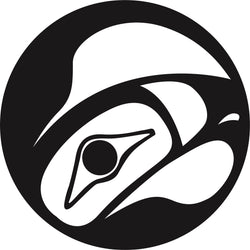$1,000.00
$1,500.00
Blue Whale- Artist Proof #10/10
- Story
The blue whale is the largest animal known to inhabit the planet. This animal can grow up to 30 meters in length, has a heart the size of a small car, and a tongue that weighs nearly three tonnes! You would think something so massive would have nothing to fear and rule in the animal kingdom.
When I researched the blue whale for this picture, I realized I knew little about them. Roy wanted to take a picture of a blue whale because it is somewhat of a mystery, and neither of us knows of anyone who has actually seen one in the wild.
What I did learn is that the main predator of the blue whale is the orca. Blue whales have no teeth and have only their sheer size to defend themselves. But orcas are not a blue whale's greatest threat. It was reported that in 2000, there were fewer than 10,000 left in our oceans due to the whaling industry. I've read different reports on the numbers of whales killed by the early part of the 20th century, all of those numbers being very well into the thousands! A worldwide ban on harvesting blue whales did not come into effect until 1966, and this animal still remains on the endangered species list. A blue whale's greatest threat has been and remains to be, humans.
The future of the blue whale remains unknown. With global warming and threats of contamination from the oil industry, it stands a good chance of becoming a thing of the past.
I would like to thank Roy for this opportunity to work with him again, and this opportunity to celebrate and bring attention to the blue whale. "Blue Whale" is the second print in a series of whales that we are collaborating on.
Story
The blue whale is the largest animal known to inhabit the planet. This animal can grow up to 30 meters in length, has a heart the size of a small car, and a tongue that weighs nearly three tonnes! You would think something so massive would have nothing to fear and rule in the animal kingdom.
When I researched the blue whale for this picture, I realized I knew little about them. Roy wanted to take a picture of a blue whale because it is somewhat of a mystery, and neither of us knows of anyone who has actually seen one in the wild.
What I did learn is that the main predator of the blue whale is the orca. Blue whales have no teeth and have only their sheer size to defend themselves. But orcas are not a blue whale's greatest threat. It was reported that in 2000, there were fewer than 10,000 left in our oceans due to the whaling industry. I've read different reports on the numbers of whales killed by the early part of the 20th century, all of those numbers being very well into the thousands! A worldwide ban on harvesting blue whales did not come into effect until 1966, and this animal still remains on the endangered species list. A blue whale's greatest threat has been and remains to be, humans.
The future of the blue whale remains unknown. With global warming and threats of contamination from the oil industry, it stands a good chance of becoming a thing of the past.
I would like to thank Roy for this opportunity to work with him again, and this opportunity to celebrate and bring attention to the blue whale. "Blue Whale" is the second print in a series of whales that we are collaborating on.

